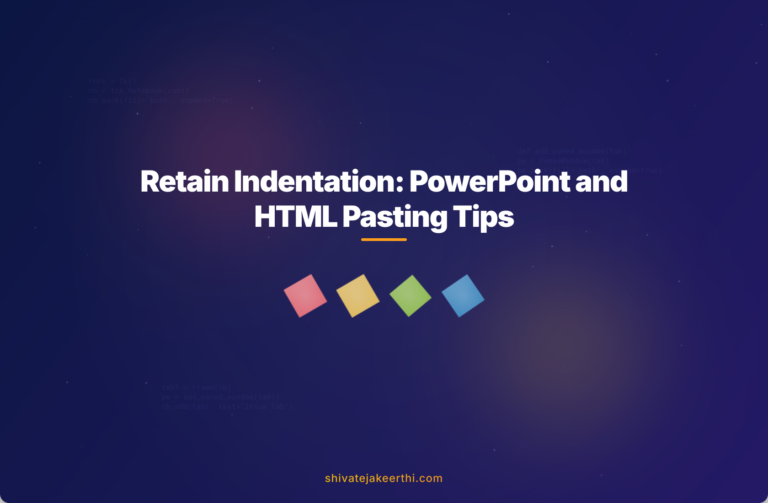When working with HTML and JavaScript, copying HTML-formatted content directly to the clipboard using the Clipboard API provides a smooth and user-friendly experience. However, anyone who’s attempted to paste copied HTML content into PowerPoint knows the frustration of losing leading spaces in the process. Why does this happen, and how can we ensure that our beautifully formatted HTML code retains its indentation when pasted into PowerPoint presentations?
Today, we’ll explore why leading spaces vanish during pasting and look into possible solutions to preserve formatting, ensuring a consistently polished look for your presentations.
How Copying HTML Using the Clipboard API Works
Before we jump into solutions, let’s first clarify how copying HTML to the clipboard typically happens. Using JavaScript, you can define HTML content and copy it using the Clipboard API combined with Blob objects and ClipboardItem.
Here’s a simplified version of how you might copy HTML to the clipboard using JavaScript:
async function copyHTMLToClipboard(htmlContent) {
const type = "text/html";
const blob = new Blob([htmlContent], {type});
const data = [new ClipboardItem({[type]: blob})];
try {
await navigator.clipboard.write(data);
console.log("Copied HTML successfully!");
} catch (err) {
console.error("Failed to copy: ", err);
}
}
In this snippet, we create a Blob containing our HTML content, define it as a ClipboardItem, and then write it directly to the clipboard. This works smoothly for most web-to-web copy-paste scenarios, retaining formatting in browsers and text editors.
But there’s a catch when it comes to pasting that content into PowerPoint.
Why the Leading Spaces Vanish When Pasted into PowerPoint
The trouble occurs specifically in scenarios where your HTML content needs indentation (e.g., code snippets) and you try pasting them into PowerPoint slides.
In a typical workflow, you copy nicely formatted HTML code from your web app and paste it into PowerPoint. To your frustration, all leading spaces (code indentations) vanish instantly, leaving your code samples messy and unreadable.
The issue is that PowerPoint, when reading HTML-formatted clipboard content, tends to ignore or collapse leading spaces. It applies its own internal logic for handling white-space formatting, significantly altering your original indents.
What Solutions Have Been Tried (And Why They Didn’t Fully Work)
While exploring a solution, several approaches are commonly recommended, each with limited success:
- Using <pre> tags or CSS white-space properties: Wrapping the content inside <pre> tags and adding CSS such as
white-space:preor even the Microsoft-specific CSS propertystyle="mso-spacerun:yes"doesn’t solve the issue when pasting directly into PowerPoint. - Replacing spaces with : Another approach is replacing spaces with non-breaking spaces (
). While this preserves indentation when pasted into PowerPoint, it introduces another issue: copying the same snippet from PowerPoint back to a plain text editor or code editor replaces normal spaces with non-breaking ones, disrupting further copying or editing.
None of these widely documented methods fully address the root issue: consistently retaining your indentation formatting without unintended side effects.
What’s the Ideal Outcome?
In an ideal situation, you’d want two specific things to happen:
- Pasting HTML (especially code snippets) into your PowerPoint presentation seamlessly maintains leading spaces, indentation, and overall formatting.
- If users copy the code back out of PowerPoint into a different editor or environment, the formatting converts ideally into regular spaces, preserving convenience and flexibility.
Essentially, the goal is user-friendliness, readability, and compatibility between applications without friction or manual corrections.
Is PowerPoint Expecting a Specific HTML Structure?
Given standard methods’ compatibility issues, it seems possible that PowerPoint expects pasted HTML content to follow a specific structure or configuration.
Microsoft Office tools, including PowerPoint, generally handle HTML pasting based on Word-specific or Office-specific HTML standards. They usually apply special handling to inline CSS styles, Microsoft Office proprietary tags, or a mixture of both. Unfortunately, the exact format or expectations for leading spaces and indentation styles aren’t clearly documented.
This naturally begs the question: does anyone know or understand exactly what HTML structure or Office-specific approach PowerPoint expects when interpreting pasted content from the clipboard? Is there a hidden Office HTML specification referencing spaces or indentation handling?
Potential Workarounds and Alternative Solutions
While searching for the perfect solution, let’s look briefly at a few potential workarounds you might experiment with:
- Using inline styles in HTML: Adding Office-supported CSS inline styles explicitly recognized by Microsoft Office XML standards, hoping these might retain indentation.
- Hybrid HTML structures: Integrating proprietary
mso-*attributes and tags compatible with Microsoft Word Documents when generating HTML. This might encourage PowerPoint to maintain the original formatting more closely. - Manual Workaround: Temporarily converting leading spaces to special characters (like ) only during the copy-to-clipboard step, then providing users instructions or a straightforward way to revert back after pasting.
Unfortunately, we can’t easily share a live demo of this problem due to browser restrictions on Clipboard API access, especially in iframes or embedded examples. But if you have a direct JavaScript environment, like your own browser-based project or plain HTML page, you can quickly reproduce and test this behavior.
Could You Help Solve the Puzzle?
We’re eager and open to tips, pointers, or solutions you’ve uncovered from personal experience. If you’ve previously tackled similar PowerPoint clipboard quirks or have found clever techniques to retain leading spaces reliably, please share your insights or reference useful resources.
The clipboard copy-paste flow between applications might seem straightforward, but unexpected quirks like these highlight the complex realities developers face daily. Your collective wisdom and experience can help resolve these little mysteries and smooth out the development experience for others.
Have you encountered (and fixed!) similar formatting issues or have recommendations on tweaking HTML structures to ensure PowerPoint-friendly pasting behavior? If so, share your thoughts below—we greatly appreciate your advice!



0 Comments